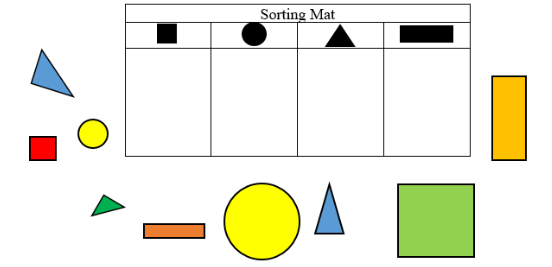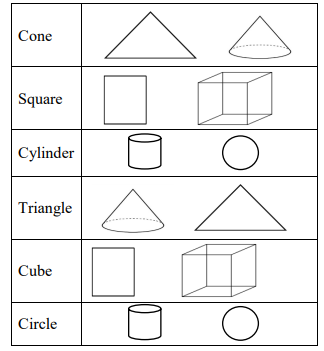Clarifications
Clarification 1: Instruction includes a wide variety of circles, triangles, rectangles, squares, spheres, cubes, cones and cylinders.Clarification 2: Instruction includes a variety of non-examples that lack one or more defining attributes.
Clarification 3: Two-dimensional figures can be either filled, outlined or both.
Benchmark Instructional Guide
Connecting Benchmarks/Horizontal Alignment
Terms from the K-12 Glossary
- Circles
- Cones
- Cubes
- Cylinders
- Rectangles
- Spheres
- Squares
- Triangles
Vertical Alignment
Previous Benchmarks
Next Benchmarks
Purpose and Instructional Strategies
The purpose of this benchmark is to help students identify specific two- and three-dimensional figures, and to make connections between the figures (MTR.2.1, MTR.5.1).- It is not the expectation of this benchmark to make distinctions between two- and three- dimensional figures.
- Instruction focuses on using a variety of figures including different orientations, such as scalene, isosceles and equilateral triangles, to build the understanding of triangles. (There is no expectation that students learn these terms, but it is important they recognize various types of triangles.) (MTR.2.1)
- Instruction for rectangles and squares includes their similarities and differences, and the relationship that all squares are rectangles, but not all rectangles are squares (MTR.5.1).
- Instruction may use manipulatives and other concrete objects to develop student understanding.
Common Misconceptions or Errors
- Students may only recognize figures in a specific orientation or angle distribution (i.e., recognizing isosceles triangles but not scalene).
- Students may not recognize that a square is also a rectangle.
- Students may sort objects by size when asked to sort by shape.
- For example, students may place large circles with large triangles, or separate large triangles and small triangles.
Strategies to Support Tiered Instruction
- Teacher provides plane figures (circles, squares, triangles, and rectangles), or solid shapes (cones, cylinders, cubes, and spheres) for students to sort.
- For example, instruction includes having the student sort the shapes by how they are same or by how they are different. The teacher may ask follow up questions such as, “How did you decide to sort the shapes? How many sides does this group have?”

- Teacher provides shapes that are cut out and present to the students in various orientations (i.e., isosceles, scalene, and right triangles): squares, circles, triangles, rectangles. Shapes are scattered in the workspace. Students work to match the squares with the squares, the circles with the circles, etc., until all shapes are grouped. The focus is on students being able to identify shapes when they are oriented differently (i.e., not sitting flat on one side). This task can be replicated for any sets of shapes students are struggling with including solid figures. If needed, reduce the type of shapes being sorted (i.e., instead of sorting 4 types of shapes, only sort 2 types of shapes).
- Teacher provides the following plane figures in multiple sizes: squares, circles, triangles, rectangles. Shapes are scattered in the workspace. Students work to match the squares with the squares, the circles with the circles, etc., until all shapes are grouped. The focus is on students recognizing that shapes of different sizes go in the same group (i.e., all circles large and small should be together). This task can be replicated for any sets of shapes students are struggling with including solid figures.
- Example:

- Teacher provides instruction by doing a “Shape Show”. The teacher shows and names a large rectangle. Walk fingers around its perimeter, describing and exaggerating the actions (straight side...turn, straight side...turn, straight side...turn, straight side...stop), while asking students how many sides the rectangle has and count the sides with him or her. Repeat the actions for a large square, drawing connections between the similarities. The teacher explains that squares are a special kind of rectangle.

Instructional Tasks
Instructional Task 1
Circle the correct item.
Instructional Items
Instructional Item 1
Using the image below, draw an “x” through all of the rectangles.
*The strategies, tasks and items included in the B1G-M are examples and should not be considered comprehensive.
Related Courses
Related Access Points
Related Resources
Formative Assessments
Lesson Plans
Original Student Tutorials
STEM Lessons - Model Eliciting Activity
In this MEA, students will sort recycling material based on the shape, name the shapes, and decide on what recycling bin would be the best for the city to choose. Students will write and draw a picture describing which recycling bin they chose.
Model Eliciting Activities, MEAs, are open-ended, interdisciplinary problem-solving activities that are meant to reveal students’ thinking about the concepts embedded in realistic situations. Click here to learn more about MEAs and how they can transform your classroom.
MFAS Formative Assessments
Students are asked to identify a triangle shown in two different orientations.
Students examine two photographs taken in a classroom and identify and name shapes whose locations are described with words.
Students name two-dimensional and three-dimensional shapes given manipulatives or pictures on a worksheet.
Original Student Tutorials Mathematics - Grades K-5
Learn the attributes, or characteristics, of a circle in this interactive tutorial.
Identify and name rectangles and squares based on their defining attributes, even if they have different sizes or positions. Join King Geo and his scout, Quad, as they search for rectangles and squares in this interactive tutorial.
This is part of a series on the defining attributes of shapes. Click the links below.
- "The Search for Shapes: Tracking Triangles"
- The Search for Shapes: Recognizing Rectangles and Squares"
Track down triangles based on their defining attributes for King Geo in this interactive tutorial. Learn what makes a triangle a triangle.
This is part of a series on the defining attributes of shapes. Click the links below.
- "The Search for Shapes: Tracking Triangles"
- The Search for Shapes: Recognizing Rectangles and Squares"
Student Resources
Original Student Tutorials
Learn the attributes, or characteristics, of a circle in this interactive tutorial.
Type: Original Student Tutorial
Identify and name rectangles and squares based on their defining attributes, even if they have different sizes or positions. Join King Geo and his scout, Quad, as they search for rectangles and squares in this interactive tutorial.
This is part of a series on the defining attributes of shapes. Click the links below.
- "The Search for Shapes: Tracking Triangles"
- The Search for Shapes: Recognizing Rectangles and Squares"
Type: Original Student Tutorial
Track down triangles based on their defining attributes for King Geo in this interactive tutorial. Learn what makes a triangle a triangle.
This is part of a series on the defining attributes of shapes. Click the links below.
- "The Search for Shapes: Tracking Triangles"
- The Search for Shapes: Recognizing Rectangles and Squares"
Type: Original Student Tutorial








